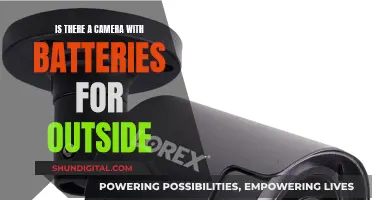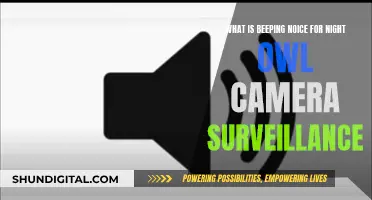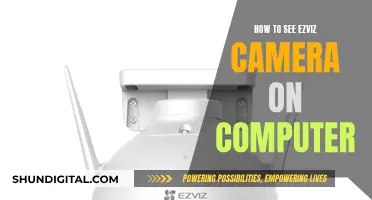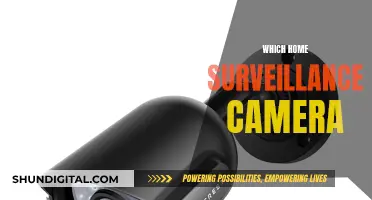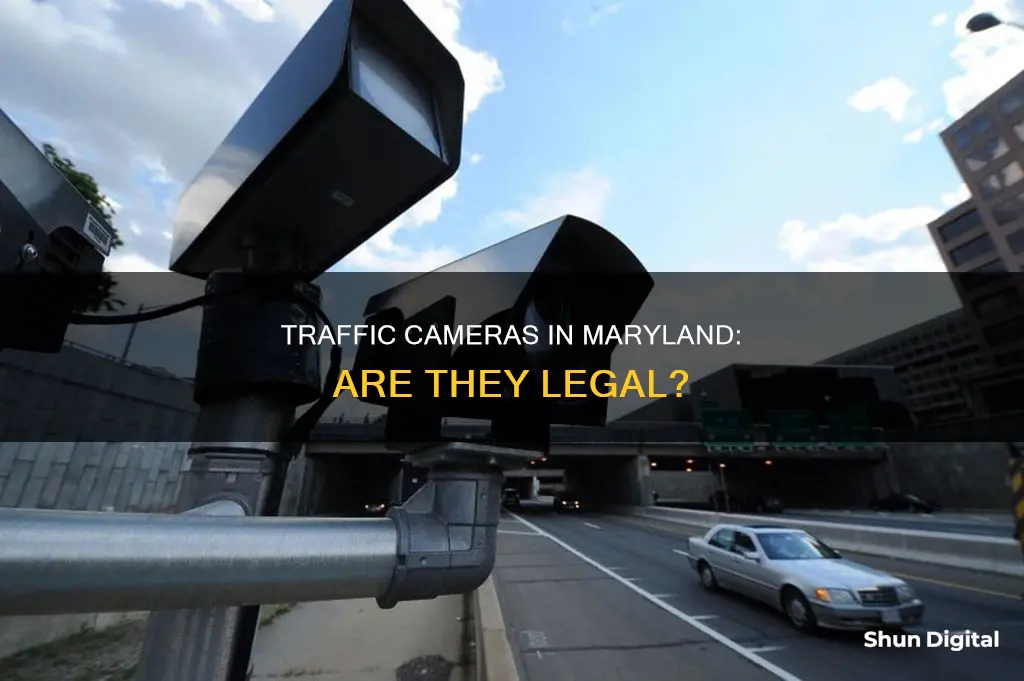
Traffic cameras in Maryland are used to enforce traffic laws by photographing drivers who break them. These cameras are positioned in high-traffic areas, dangerous sections of roads, and school zones. They capture images of vehicles that run red lights or exceed the speed limit by at least 12 miles per hour. The legality of these traffic cameras is evident as they serve as a tool for police officers to enforce traffic laws, reduce violations, and improve road safety. While some drivers may question the accuracy of the cameras, they have the right to challenge any citations received. The use of traffic cameras in Maryland is therefore a legal and effective method to promote safer driving habits and reduce the number of accidents.
| Characteristics | Values |
|---|---|
| Purpose | To photograph drivers running red lights and enforce traffic laws |
| Function | Takes two photos of the violating car, including its license plate, and automatically issues a ticket |
| Fine | $75 |
| Speed limit enforcement | Fined $40 for going at least 12 mph over the speed limit |
| Criminal record | No points on license, no criminal record |
| Insurance | Insurance companies are not notified |
What You'll Learn

Red light cameras in Maryland
Red light cameras are legal in Maryland and are used to enforce laws that require drivers to stop at red lights. These cameras are placed at intersections and are equipped with detectors that capture a coloured photograph of a vehicle just before it crosses the stop line. A second picture is taken soon after, showing the car in the intersection. Both photographs display the traffic signal, the violating car, and the car's position relative to the stop line on the road.
Red light cameras are known to reduce the number of violations and crashes at intersections. They also act as deterrents, encouraging safer driving habits. Once the 30-day warning period after the installation of a new red light camera expires, violators will receive citations with a $75 fine.
Photo-enforced tickets are also issued when a vehicle passes a fixed-camera location by at least 12 miles per hour over the speed limit. The cameras capture the license plate of the speeding vehicle, and the owner is mailed a copy of the violation, including photographs and the speed the vehicle was travelling. The fine for this violation is $40, which can increase if not paid on time.
Drivers who receive a ticket can challenge the citation in Maryland District Courts. They may argue that they were not driving the vehicle or that the camera improperly recorded their speed. An attorney could help contest a ticket, providing defences and information to challenge or mitigate the citation.
The Polaroid Camera: Materials and Components
You may want to see also

How tickets are issued
In Maryland, traffic cameras are used to enforce laws that require drivers to stop at red lights or to monitor their speed. When a driver runs a red light, detectors on the street detect the violation and a camera takes two photographs of the car: one just before it crosses the stop line and another after it has entered the intersection. Both photographs show the traffic signal, the car, and its position relative to the stop line. The owner of the vehicle will then receive a violation notice in the mail, which they can pay online, in person, or by mail, or they can request a trial.
For speed violations, cameras are positioned in high-traffic areas, dangerous sections of the roadway, places with a high risk of speeding, school zones, and areas that have received complaints from the public. They are calibrated to only record incidents where drivers are going 12 or more miles per hour over the speed limit. When a violation occurs, the camera takes a photograph of the passing car, including the license plate, which is then reviewed to identify the owner of the vehicle. The owner will then be mailed a copy of the violation, including photographs and the speed the vehicle was traveling.
Violators of red light and speed camera violations must pay a fine, which is $75 for red light violations and $40 for speeding. These fines can increase if not paid on time. These types of violations are considered civil violations rather than criminal matters, so drivers will not receive points on their driver's licenses and insurance providers will not be notified.
If a driver wishes to contest a ticket, they can do so by requesting a trial or a waiver hearing within 30 days of receiving the citation. During a waiver hearing, the driver can ask the judge to reduce or waive the fine, or request probation instead of a conviction. The judge has the discretion to lower or increase the fine, up to a maximum of $500. If the judge renders a guilty verdict, the driver has the right to appeal within 30 days.
Rechargeable Camera Batteries: Charged or Not When Bought?
You may want to see also

Fines and penalties
Traffic cameras in Maryland are legal and are used to enforce traffic laws. These cameras are often placed in residential areas, school zones, and construction zones to monitor speeding and red-light violations. While these infractions are considered minor offenses, they can result in fines and other penalties for the vehicle owner.
When a vehicle is captured speeding by a traffic camera, the registered owner will receive a citation, or ticket, in the mail. This citation will include photographs of the vehicle, its license plate, and information about the speed it was travelling. The standard fine for speeding violations is $40 per violation, but this can increase if not paid on time.
Similarly, red light camera tickets carry a $75 fine. In both cases, there are no points assigned to the driver's record, and insurance companies are not notified of the violation. These tickets are considered civil infractions, with no criminal consequences.
It is important to note that failure to respond to a traffic camera ticket can result in additional fees and penalties. Vehicle owners have the option to pay the fine or contest the ticket in a Maryland District Court. If they choose to contest the ticket, they may need to provide evidence to support their claim, such as proof that they were not driving the vehicle at the time of the violation or documentation of a medical condition that affected their driving.
If a vehicle owner chooses to ignore the citation, the Motor Vehicle Administration (MVA) will be notified, and the driver's license suspension process will be initiated. Driving with a suspended license is a criminal offense that can result in incarceration. Therefore, it is crucial to take action within the given timeframe, typically 30 days, to avoid further legal consequences.
To avoid these unwanted burdens, individuals are advised to seek legal assistance from an experienced traffic attorney. An attorney can guide them through the process, help gather evidence, and represent them in court if needed. By working with a lawyer, individuals may be able to reduce or dismiss the citation and minimize any potential penalties.
Fight School Bus Camera Tickets: Know Your Rights
You may want to see also

Contesting a ticket
Traffic cameras in Maryland are legal. These automated systems are designed to detect and capture images of vehicles exceeding the speed limit or running red lights. While these camera tickets are legal, you have the right to contest them. Here is a step-by-step guide on how to contest a traffic camera ticket in Maryland:
Step 1: Understand Your Ticket
When you receive a traffic camera ticket, it will include information about the violation and instructions on how to pay the fine or contest the ticket. It is important to carefully review the details of the ticket, including the violation, location, date, and time.
Step 2: Decide to Contest
If you choose to contest the ticket, you must take action within the specified timeframe, typically within 30 days from the date of the citation. Failing to respond within this timeframe can result in additional penalties and fees.
Step 3: Gather Evidence
Start collecting evidence that can support your case. This may include photographs of the area where the violation occurred, maintenance records of the traffic camera, and statements from any passengers or witnesses who can provide a different account of the events.
Step 4: Prepare Your Documentation
Ensure you have all the relevant documentation, such as the ticket itself, your vehicle registration, and any other correspondence related to the ticket. Having this documentation organized and readily available will be crucial for the next steps.
Step 5: Identify Possible Defenses
There are several possible defenses you can use to contest the ticket:
- Challenge the accuracy of the camera: Request maintenance and calibration records to determine if the camera was functioning correctly at the time of the alleged violation.
- Signage issues: Argue that the signage indicating speed limits or the presence of traffic cameras was missing, obscured, or incorrectly placed. Take photographs of the current signage to support your claim.
- Mistaken identity: If you believe the camera captured the wrong vehicle, gather evidence to prove that you were not driving in that area at the time of the violation.
- Procedural errors: Look for any procedural errors or mistakes in the ticket issuance, such as incorrect information on the citation. These errors may result in the ticket being dismissed.
Step 6: Request a Hearing
You can usually request a hearing by mail, online, or by calling the contact number provided on the ticket. During the hearing, you will have the opportunity to present your evidence and arguments to the judge, who will make a decision based on the presented evidence.
Step 7: Prepare for the Hearing
Clearly and concisely prepare your presentation, covering all relevant points. The judge will examine the evidence and listen to both your argument and the prosecution's case. They may ask questions for further clarification.
Step 8: Await the Outcome
After reviewing the evidence and hearing both sides, the judge will decide whether to uphold the ticket, reduce the fine, or dismiss the ticket entirely. Remember that you have the right to appeal the judge's decision if you are not satisfied with the outcome.
How to Extend Your Camera's Battery Life
You may want to see also

Camera calibration
The use of traffic cameras in Maryland is legal. These cameras are placed across the state, especially in high-traffic areas, and are used to enforce traffic laws. For example, red-light cameras in Maryland take photographs of drivers running red lights and automatically issue tickets. Similarly, photo-enforced tickets are issued when a vehicle passes a fixed-camera location while going at least 12 miles above the speed limit.
Now, here is some detailed information about camera calibration:
One common method for camera calibration is the use of a checkerboard calibration target. This involves placing a checkerboard with a known pattern and size in front of the camera and capturing multiple images from different angles and distances. By analyzing the position and distortion of the checkerboard pattern in the captured images, the calibration software can calculate the camera's intrinsic and extrinsic parameters.
Intrinsic parameters include focal length, principal point, and lens distortion, which describe the camera's internal properties. Extrinsic parameters refer to the camera's position and orientation in 3D space.
Another important aspect of camera calibration is choosing the appropriate camera model. Common models include the central and non-central generic models, which support a wide range of cameras and allow for highly accurate calibration. The selected model should fit the specific requirements and characteristics of the camera being calibrated.
Additionally, the calibration process should consider the density of the calibration pattern. A high-resolution camera can capture more features, so a higher feature density is beneficial. On the other hand, a low-resolution camera may struggle with a dense pattern, and a less dense pattern might be more suitable.
It's also crucial to ensure full coverage of the camera's field of view during calibration. The calibration pattern should be shown to the camera from various angles and distances, especially focusing on the image corners to obtain sufficient detections in those areas.
Overall, camera calibration is a meticulous process that requires careful consideration of various factors. By following the recommended steps and choosing the right tools, such as the camera calibration software and appropriate calibration patterns, accurate and reliable results can be achieved.
Sony Camera Production: Where Are They Made?
You may want to see also
Frequently asked questions
Yes, traffic cameras are legal in Maryland. These include red light cameras and speed cameras.
Red light cameras are devices that photograph drivers running red lights and automatically issue tickets.
Detectors in the street will detect the violation and the camera will take two photographs: one of the car before it crosses the stop line, and one of the car in the intersection. Both photos will show the traffic signal and the car's position. The owner of the vehicle will then receive a violation notice in the mail.
Speed cameras in Maryland take a photograph of a passing car, including the license plate, if the vehicle is going at least 12 miles above the speed limit. The photo of the license plate will be reviewed to identify the owner of the vehicle, who will then be mailed a copy of the violation, including photographs and the speed the vehicle was traveling.


